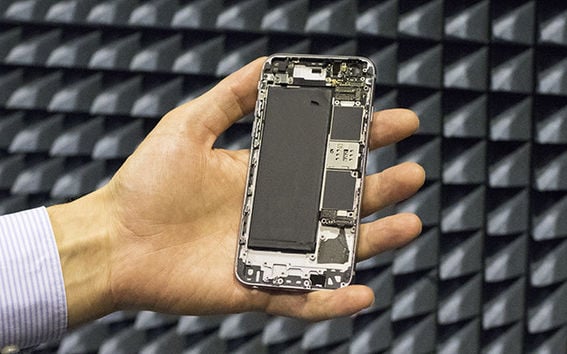New digital antenna could revolutionise the future of mobile phones

The phone's antennas are placed in the top and bottom, which means that the phone's touch screen does not cover the entire phone. With the help of new developed method the antennas need less space and the phone display can be made larger and the phone design can be more free.
Aalto University's Radio Science and Engineering researchers have developed a method that allows antennas to make the shift from the analogue to the digital world. The antennas currently in use are mostly based on technology developed half a century ago.
‘Traditionally one antenna works with either one or a few different frequencies. Now we can take advantage of advanced digital electronics and combine several small antenna elements to work together as one antenna that can be made to operate digitally with any frequency. In this way, many smartphone applications like GPS, Bluetooth and Wi-Fi will no longer need their own antennas. Instead, all of the phone’s data transfer can take place through one digitally controlled antenna. This in turn makes phone design easier and enables a larger screen size relative to phone size as the antenna does not require so much space’, explains doctoral candidate Jari-Matti Hannula.
The new antenna also makes it possible to reach the data transfer speed set as the objective for the next generation of phones, which is 100 to 1000 times faster than that of current phones. In addition, battery life will be improved owing to the greater efficiency of the new method.
Antenna control requires new technology
Thanks to the new method, the antenna can have even greater bandwidth, which leads to a higher data transfer speed and improved efficiency. These new antennas may also dispose of the analogue components that traditional antennas use to tune into the desired frequency. This facilitates antenna design and enables the creation of more compact antennas with better radiation efficiency.
With antennas designed using the standard technology, it is possible to obtain either a broad frequency range or high efficiency, but not both at the same time. Antennas’ radiation efficiency has in recent times been falling because the frequency range used by mobile phones has been continuously increasing. Poor radiation efficiency leads to a short transmission range, for which network operators are then forced to compensate with a denser network of base stations. Energy is wasted in both the phone and the base station. In addition, increasing the network density is expensive.
Professor of Radio Engineering Ville Viikari believes that the new method will revolutionise the fifth generation of mobile phones and maintain Finland as one of the leading countries in the development of mobile phone antennas. For example, the antenna type developed by the Department of Radio Science and Engineering at the beginning of the 21st century is the main type in use in current phones. Now is the time to forge the solutions for a new generation of mobile devices.
'The next step in the development process is under way with the commencement of tests in cooperation with Huawei using fifth generation mobile phone devices. We are also developing together with Aalto University researchers digital electronic systems for controlling the antennas’, Mr Viikari adds.
An article detailing the principles of the method has been published in journal IEEE Antennas and Wireless Propagation Letters. Link to the article.
More information:
Professor Ville Viikari
Aalto University
tel +358 50 4135 458
[email protected]
Doctoral candidate Jari-Matti Hannula
Aalto University
tel +358 50 4677 042
[email protected]
Read more news

Get to know us: Associate Professor Maria Sammalkorpi
Sammalkorpi received her doctorate from Helsinki University of Technology 2004. After her defence, she has worked as a researcher at the Universities of Princeton, Yale and Aalto.
Aalto computer scientists in ICML 2024
Computer scientists in ICML 2024
In low-hierarchy organisations, even key policy issues are discussed in Slack
In a recent study, Aalto University alumn Lauri Pietinalho, a visiting scholar at New York University's Stern School of Business, and Frank Martela, an assistant professor at Aalto University, investigated how low-hierarchy organisations deal with shared policies in confrontational situations and how authority functions within them.